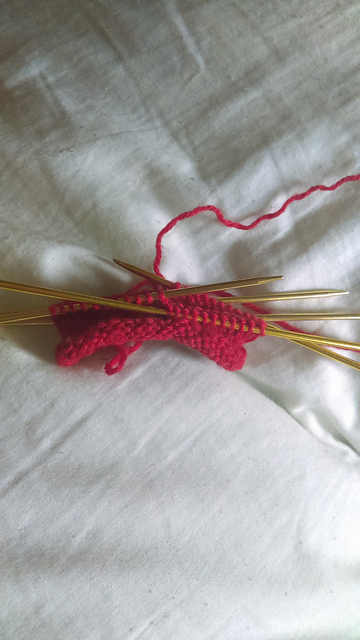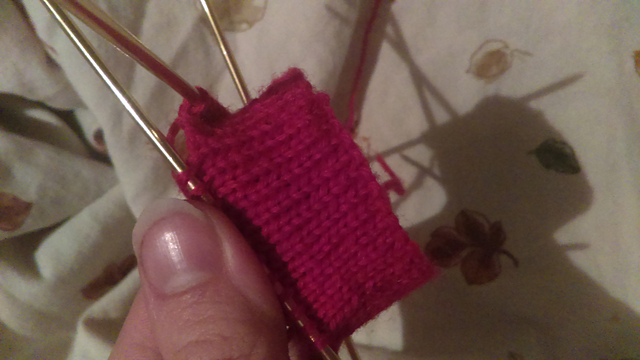My mitten begins with 44 stitches, cast on using the backwards loop method, over two US size 2 double pointed needles held together. This creates a nice, loose edge that will stretch easily to admit a hand, and will also be easy to pick up stitches from later on. The 44 stitches divide evenly over four needles, and I join in the round and knit every stitch for about an inch.
If I just keep knitting every stitch, the bottom edge of the mitten curls up into a rolled edging that no amount of blocking will keep flat.
To avoid this, I could have alternated the rounds of the first inch with knitting and purling for a garter stitch edge, or I could have opted to do the entire cuff in ribbing, two of the most common ways to keep roll-happy stockinette stitch in check.
The mittens I'm using for reference, however, appear to have a faced, or folded, hem, so that is the edging technique I am using. After that first inch of all knit rows, I purl one round, and then continue knitting.
This creates a line where the fabric naturally wants to fold inward, because of the same stitch tension that causes the knit rounds to fold outward. When I fold the bottom edge up to the inside, that round of purls creates a new, very tidy edging.
I keep knitting until there's about an inch of rounds above the turning ridge.
When folded up to the inside, the cast-on edge lines up with the stitches on the needles. On the next round, as I insert my working needle into each stitch, I also pick up a loop off the cast-on, and work them as one, like a K2tog decrease.
After I've done this all the way around, joining each live stitch with a loop from the cast-on, the edge is completely secured, and I have a lovely folded hem.
If joining the hem as you go is too much stitch juggling for you, it may be simpler to whip-stitch the edge to the inside after you've finished knitting the mitten, but personally I never sew when knitting can get the job done just as neatly. You could also leave the hem completely unattached, and pick up the lining directly from the cast-on edge, which I probably would have done if I wasn't so enamored of the join-as-you-go method. As it is, the join leaves a little ridge on the inside that will work just as well as a place to pick up the stitches later on.
PS, if instead of a purl row, you (YO, K2tog) across the turning row, the end result will be a picot hem, which is an adorable, feminine edging option.







I wish I could knit! So many interesting tidbits with the A to Z Challenge! That looks like it will be a very nice mitten.
ReplyDelete@IsaLeeWolf
A Bit to Read